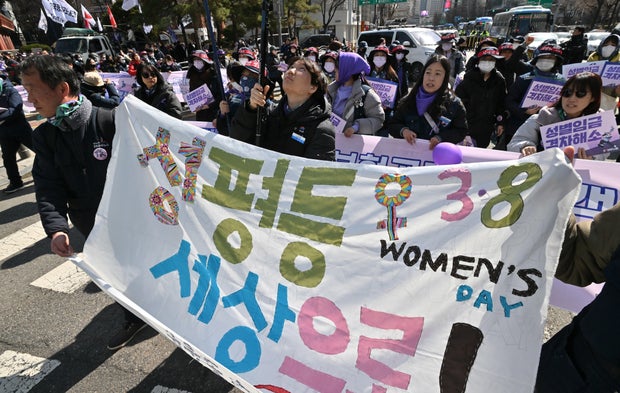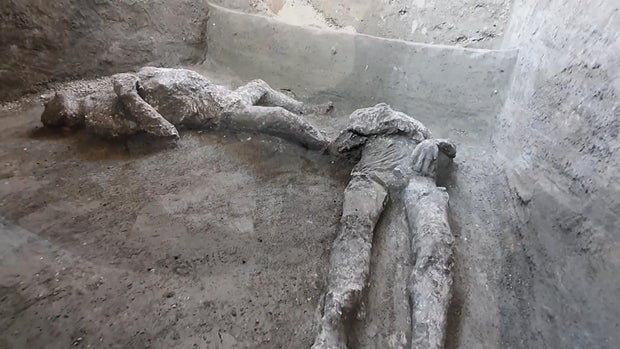CBS News
What to know about the interest rate cut expected from the Federal Reserve

Watch CBS News
Be the first to know
Get browser notifications for breaking news, live events, and exclusive reporting.
CBS News
What is the 4B movement? Why some are calling for a South Korean-inspired trend after Trump’s victory

After President-elect Donald Trump’s victory against Vice President Kamala Harris in the 2024 presidential election was driven in part by young male voters, some are calling for the use of South Korea’s “4B Movement” in the United States.
The presidential election was seen by many as a referendum on women’s rights. Trump has been found liable for sexual abuse and defamation, and his vice president, former Ohio senator JD Vance, has previously referred to some women as “childless cat ladies.” The Harris campaign also ran on a platform of supporting a woman’s right to abortion, something that has been jeopardized in many states after the fall of Supreme Court decision Roe v. Wade, which Trump has taken credit for.
Now, some women are swearing to abide by the code of the “4B movement,” a South Korean feminist approach that swears off men. Here’s what to know about the 4B movement.
What is the 4B movement?
In short, the 4B movement is a vow to swear off men. It is called the 4B movement because in Korean, the four tenets each begin with bi, which means no, according to a paper published by two South Korean researchers at Yonsei University’s Institute of Humanities.
The movement specifically calls for the refusal of dating men (biyeonae), sexual relationships with men (bisekseu), heterosexual marriage (bihon), and childbirth (bichulsan) in response to what South Korean women see as a patriarchal and misogynistic culture. The movement is also known as the “4 Nos.”
The 4B movement began in 2017 and gained more attention in 2019, amid a #MeToo-style reckoning in South Korea. Much of the movement has been built online, where participants call themselves “anonymous women” and share few personal details. It has no official leadership structure.
JUNG YEON-JE/AFP via Getty Images
Women in the nation have fought against what Human Rights Watch calls “shockingly widespread” gender-based violence and called for harsher penalties for what’s called “spy cam porn.” They have also criticized the country’s extreme gender wage gap, which saw women paid 31.2% less than men in 2022, according to the KoreaTimes, and called out hiring discrimination and harassment in the workplace.
What impact has the 4B movement had in South Korea?
The 4B movement has been controversial in South Korea. The country’s president Yoon Suk-yeol said in 2021 that feminist movements were “blocking healthy relationships” between men and women in the nation.
The nation has been battling a declining birth rate for several years, which some credit to the 4B movement, according to The New York Times.
The 4B movement in the United States
After Trump’s election victory on Tuesday, women on social media have expressed interest in following the “4 Nos” of the movement. Trump made strong inroads with young men under 30, according to exit polls from CBS News.
Since the election, multiple far-right figures have made alarming statements about women’s rights on social media. White nationalist Nick Fuentes, who dined with Trump at Mar-a-Lago in 2022, wrote “Your body, my choice. Forever.” in a widely-criticized post on X. Similar posts have percolated across social media.
In response, women have called for an American version of the 4B movement. Use of the phrase on social media and in searches has skyrocketed. Some have also referenced “Lysistrata,” a Greek comedy where women take part in a sex strike to convince the men in their lives to end a war.
“We can’t let these men have the last laugh… we need to bite back,” wrote one X user in a post that has garnered nearly 450,000 likes.
CBS News
Federal Reserve interest rate news expected days after Trump wins 2024 election

Watch CBS News
Be the first to know
Get browser notifications for breaking news, live events, and exclusive reporting.
CBS News
New DNA evidence at Pompeii reveals surprises about identities of Vesuvius eruption victims

When a volcanic eruption buried the ancient city of Pompeii, the last desperate moments of its citizens were preserved in stone for centuries.
Observers see stories in the plaster casts later made of their bodies, like a mother holding a child and two women embracing as they die.
But new DNA evidence suggests things were not as they seem — and these prevailing interpretations come from looking at the ancient world through modern eyes.
“We were able to disprove or challenge some of the previous narratives built upon how these individuals were kind of found in relation to each other,” said Alissa Mittnik of the Max Planck Institute for Evolutionary Anthropology in Germany. “It opens up different interpretations for who these people might have been.”
Mittnik and her colleagues discovered that the person thought to be a mother was actually a man unrelated to the child. And at least one of the two people locked in an embrace — long assumed to be sisters or a mother and daughter – was a man. Their research was published Thursday in the journal Current Biology.
CBS News
The team, which also includes scientists from Harvard University and the University of Florence in Italy, relied on genetic material preserved for nearly two millennia. After Mount Vesuvius erupted and destroyed the Roman city in 79 A.D., bodies buried in mud and ash eventually decomposed, leaving spaces where they used to be. Casts were created from the voids in the late 1800s.
Researchers focused on 14 casts undergoing restoration, extracting DNA from the fragmented skeletal remains that mixed with them. They hoped to determine the sex, ancestry and genetic relationships between the victims.
There were several surprises in “the house of the golden bracelet,” the dwelling where the assumed mother and child were found. The adult wore an intricate piece of jewelry, for which the house was named, reinforcing the impression that the victim was a woman. Nearby were the bodies of another adult and child thought to be the rest of their nuclear family.
DNA evidence showed the four were male and not related to one another, clearly showing “the story that was long spun around these individuals” was wrong, Mittnik said.
Researchers also confirmed Pompeii citizens came from diverse backgrounds but mainly descended from eastern Mediterranean immigrants – underscoring a broad pattern of movement and cultural exchange in the Roman Empire. Pompeii is located about 150 miles (241 kilometers) from Rome.
The study builds upon research from 2022 when scientists sequenced the genome of a Pompeii victim for the first time and confirmed the possibility of retrieving ancient DNA from the human remains that still exist.
“They have a better overview of what’s happening in Pompeii because they analyzed different samples,” said Gabriele Scorrano of the University of Rome Tor Vergata, a co-author of that research who was not involved in the current study. “We actually had one genome, one sample, one shot.”
Though much remains to be learned, Scorrano said, such genetic brushstrokes are slowly painting a truer picture of how people lived in the distant past.
In August, archaeologists at Pompeii announced they had unearthed the remains of two more victims — a man and a woman discovered inside what was likely the bedroom of their home, where they’d become trapped as the rest of the structure filled with debris. The woman was found on the bed with a collection of gold, silver and bronze coins, as well as a pair of gold earrings, a pair of pearl earrings and other jewelry.
Earlier this year, three researchers won a $700,000 prize for using artificial intelligence to read a 2,000-year-old scroll that was scorched in the Vesuvius eruption.
The Herculaneum papyri consist of about 800 rolled-up Greek scrolls that were carbonized during the 79 CE volcanic eruption that buried the ancient Roman town, according to the organizers of the “Vesuvius Challenge.”
The scroll’s author was “probably Epicurean philosopher Philodemus,” writing “about music, food, and how to enjoy life’s pleasures,” wrote contest organizer Nat Friedman on social media.
The scrolls were found in a villa thought to be previously owned by Julius Caesar’s patrician father-in-law, whose mostly unexcavated property held a library that could contain thousands more manuscripts.









